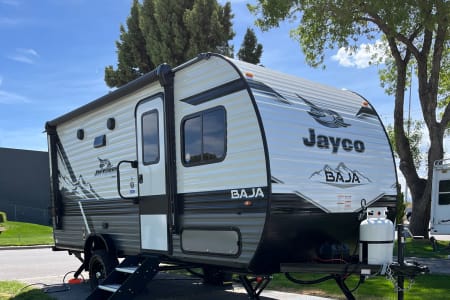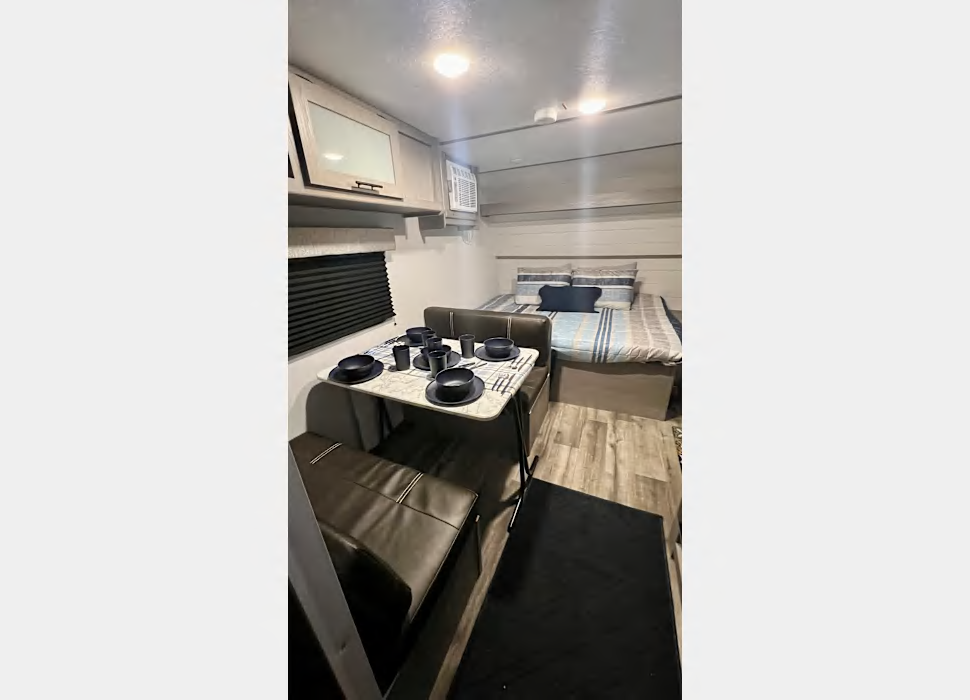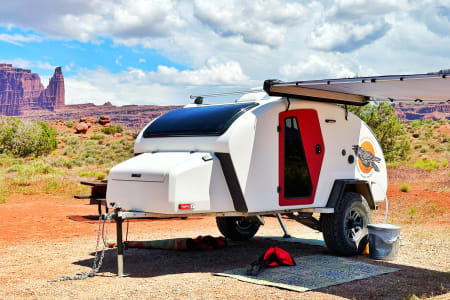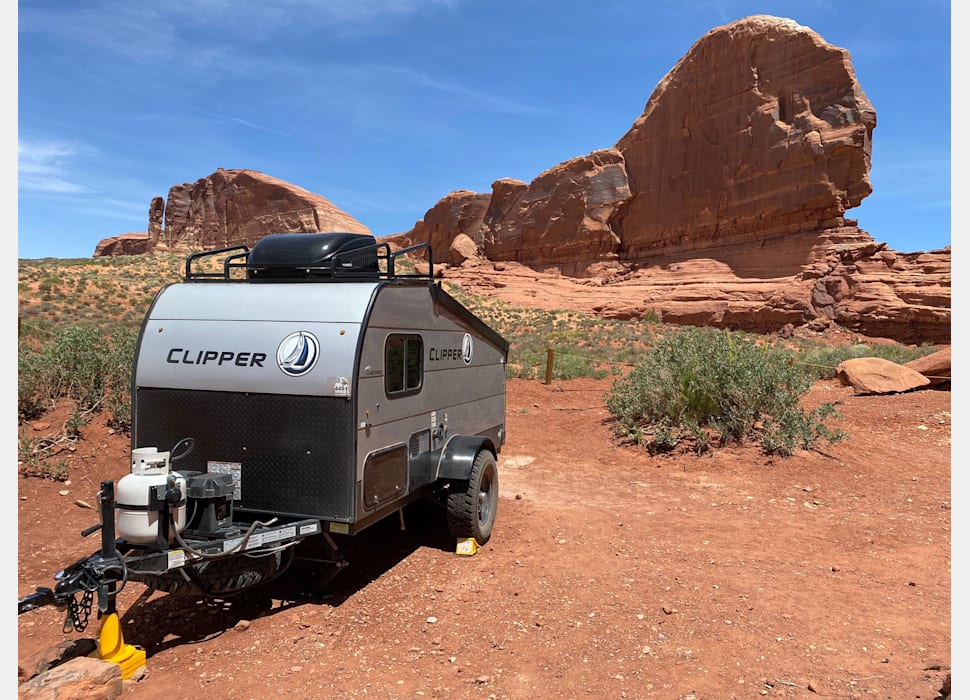Canyonlands National Park Utah (UT) RV Rentals
RV Rentals Dates
RV Rentals near Canyonlands National Park?
Introduction
Canyonlands National Park is a dream destination for RV camping enthusiasts, offering a unique blend of natural beauty, rich history, and thrilling outdoor activities. Located in southeastern Utah, this park attracts visitors from all over the world with its breathtaking landscapes and unparalleled recreational opportunities.
The history and cultural significance of Canyonlands National Park are deeply rooted in the Native American tribes that once inhabited the area. The park is home to numerous archaeological sites, including ancient rock art panels and ruins, which provide a glimpse into the lives of the Ancestral Puebloans and other native cultures. Exploring these sites allows visitors to connect with the rich heritage of the region and appreciate the resilience of its past inhabitants.
RVThereYet.com is an RV rental company, offering a diverse fleet of motorhomes, including Class A, Class B, and Class C Rentals, Travel, Trailers, and Motorhomes for unforgettable adventures in scenic RV parks and campsites in Canyonlands National Park. Ensure early reservations for camper rentals at Canyonlands National Park.
Transportation
-
Driving/Transportation
When visiting Canyonlands National Park, the primary mode of transportation is private vehicle travel. Visitors can access the park from different entrances, each offering unique experiences. The Island in the Sky district is accessible via State Route 313, while the Needles district can be reached via State Route 211. The Maze district requires high-clearance, four-wheel-drive vehicles and is accessible from various points. It’s important to note that there are restrictions on rig sizes, with a maximum length of 28 feet for vehicles and 10 feet for trailers in the park. So, hop in your private vehicle and embark on an unforgettable journey through the stunning landscapes of Canyonlands National Park.
-
Parking area
Canyonlands National Park offers designated RV parking areas at various campgrounds throughout the park. These campgrounds provide spaces specifically designed to accommodate RVs allowing visitors to park their vehicles comfortably. However it’s important to note that overnight parking outside of designated campsites is not permitted. While it is possible to camp with an RV in the park exploring the park using alternative transportation methods such as hiking or biking is highly recommended to fully experience the natural wonders and avoid any limitations posed by RV size and restrictions.
-
Public Transportation
Canyonlands National Park does not have any public transportation options such as shuttle buses or walking paths for getting around the park. The park is best explored using private vehicles or alternative transportation methods like hiking or biking. With its vast landscapes and multiple entrances having your own transportation allows for flexibility and the ability to fully immerse yourself in the beauty of the park at your own pace.
Top Campsites in Canyonlands National Park
-
Reservations camping
Dead Horse Point State Park Campground
Located just outside of Canyonlands National Park Dead Horse Point State Park Campground is a highly sought-after camping destination. With stunning views of the Colorado River and the famous Dead Horse Point this campground offers 21 spacious sites for RVs and tents. Activities include hiking mountain biking and scenic drives. The campground provides amenities such as restrooms showers and a dump station. It is pet-friendly but pets must be kept on a leash. The campground is open year-round and reservations are highly recommended.
Moab KOA Campground
Situated in the heart of Moab the Moab KOA Campground is a popular choice for visitors exploring Canyonlands National Park. This campground offers a range of accommodation options including RV sites tent sites and cabins. With amenities such as a swimming pool hot tub and playground there’s something for everyone. Activities include hiking biking and Jeep tours. The campground is pet-friendly and offers a Kamp K9 dog park. It is open year-round and reservations are highly recommended.
Canyonlands RV Resort & Campground
Located in Moab the Canyonlands RV Resort & Campground is a well-equipped campground with a range of amenities. The campground offers full hook-up RV sites tent sites and cabins. Amenities include a swimming pool hot tub laundry facilities and a camp store. Activities in the area include hiking biking and off-roading. The campground is pet-friendly and provides a dog park. It is open year-round and reservations are recommended.
Archview RV Resort & Campground
Situated just 8 miles north of Moab Archview RV Resort & Campground offers stunning views of the surrounding red rock formations. The campground features full hook-up RV sites tent sites and cabins. Amenities include a swimming pool hot tub and a camp store. Activities in the area include hiking biking and rock climbing. The campground is pet-friendly and offers a dog park. It is open year-round and reservations are recommended.
Please note that RV and trailer sizes permitted may vary at each campground so it’s important to check with the specific campground for size restrictions. Additionally availability and opening months may vary so it’s advisable to make reservations in advance to secure your spot at these popular campsites near Canyonlands National Park.
-
First-come first-served
Willow Flat Campground
Willow Flat Campground is a first-come-first-served campground located in the Island in the Sky district of Canyonlands National Park. It offers 12 individual sites and is open year-round although availability may vary during the winter months due to weather conditions. The campground can accommodate tents and small RVs up to 28 feet in length. However there are no hook-ups available. Pets are allowed but must be kept on a leash at all times.
Squaw Flat Campground
Squaw Flat Campground is another first-come-first-served campground in the Needles district of Canyonlands National Park. It has 26 individual sites and is open year-round although availability may be limited during the winter months. The campground can accommodate tents and RVs up to 28 feet in length. There are no hook-ups available but vault toilets and picnic tables are provided. Pets are allowed but must be kept on a leash at all times.
Gooseberry Campground
Gooseberry Campground is a small first-come-first-served campground located in the Island in the Sky district of Canyonlands National Park. It has 7 individual sites and is open year-round but availability may be limited during the winter months. The campground can accommodate tents and small RVs up to 28 feet in length. There are no hook-ups available but vault toilets and picnic tables are provided. Pets are allowed but must be kept on a leash at all times.
These first-come-first-served campgrounds offer a more spontaneous camping experience in Canyonlands National Park. However it’s important to arrive early to secure a spot especially during peak seasons. As always it’s advisable to check the park’s website or contact the park directly for the most up-to-date information regarding availability and any potential closures.
-
Alternate camping
If the campsites inside Canyonlands National Park are full there are alternative camping options available nearby for RV renters to consider. Here are a couple of options to explore
Private Campgrounds
There are several private campgrounds located near Canyonlands National Park that offer RV camping. These campgrounds often provide a range of amenities such as full hook-ups showers laundry facilities and recreational activities. Some popular private campgrounds in the area include Moab Valley RV Resort & Campground Portal RV Resort and Spanish Trail RV Park. These campgrounds offer convenient access to the park and can be a great alternative when the park’s campsites are full. It’s advisable to make reservations in advance especially during peak seasons.
Backcountry Camping
For those seeking a more remote and adventurous camping experience backcountry camping is an option to consider. Canyonlands National Park offers backcountry camping permits for designated sites within the park. These permits allow RV renters to camp in more secluded areas and immerse themselves in the park’s rugged landscapes. It’s important to note that backcountry camping requires careful planning and adherence to Leave No Trace principles. Permits can be obtained from the park’s visitor center and it’s recommended to familiarize yourself with the park’s regulations and safety guidelines before embarking on a backcountry camping trip.
These alternative camping options provide RV renters with flexibility and the opportunity to explore the stunning landscapes surrounding Canyonlands National Park. Whether you choose a private campground with modern amenities or opt for a backcountry camping adventure there are plenty of options to ensure a memorable and enjoyable camping experience near the park.
-
General activities
Hiking
Hiking is one of the most popular activities in Canyonlands National Park offering a variety of trails for all skill levels. From easy walks along the rim to challenging treks into the canyons hikers can explore the park’s stunning landscapes and discover hidden gems. Notable hikes include the Mesa Arch Trail Grand View Point Trail and the iconic Chesler Park Loop in the Needles district.
Mountain Biking
With its rugged terrain and scenic trails Canyonlands National Park is a paradise for mountain biking enthusiasts. The White Rim Road is a must-do for experienced bikers offering a 100-mile loop that showcases breathtaking vistas and challenging terrain. Cyclists can also explore the Slickrock Bike Trail a world-renowned trail known for its unique sandstone surface and thrilling descents.
Jeep Tours
For those looking for an off-road adventure Jeep tours are a popular way to explore the park’s remote areas. Experienced guides take visitors on thrilling rides along rugged trails providing access to stunning viewpoints and hidden canyons. The Shafer Trail and the challenging Elephant Hill in the Needles district are among the most sought-after Jeep tour routes.
Photography
Canyonlands National Park is a photographer’s dream with its dramatic landscapes and ever-changing light. From capturing the sunrise at Mesa Arch to capturing the vibrant hues of sunset over the canyons there are endless opportunities for stunning photographs. The park offers numerous viewpoints and iconic landmarks that make for unforgettable shots.
Stargazing
With its remote location and minimal light pollution Canyonlands National Park provides a perfect setting for stargazing. On clear nights the dark skies come alive with countless stars offering a mesmerizing celestial display. Visitors can set up their telescopes or simply lay back and enjoy the awe-inspiring beauty of the night sky.
These recreational activities attract outdoor RV campers to Canyonlands National Park offering a chance to immerse themselves in the park’s natural wonders and create unforgettable memories. Whether it’s hiking through breathtaking canyons biking along challenging trails or capturing the beauty of the park through photography there’s something for every outdoor enthusiast in this remarkable national park.
-
Alternative activities
Scenic Drives
For RV campers who prefer a more relaxed way to explore the park scenic drives are a popular choice. Canyonlands National Park offers several breathtaking drives including the White Rim Road and the Shafer Trail. These routes provide stunning vistas of the canyons and offer numerous pullouts for photo opportunities. The Island in the Sky scenic drive is another must-do offering panoramic views of the surrounding landscapes.
Nature Watching
Canyonlands National Park is home to a diverse range of wildlife making it a great destination for nature enthusiasts. RV campers can spot various species of birds including golden eagles and peregrine falcons soaring through the skies. Bighorn sheep mule deer and even elusive mountain lions can also be spotted in the park. Visitors can bring binoculars and spend time observing these fascinating creatures in their natural habitat.
Sunset Viewing
Canyonlands National Park offers breathtaking sunset views that are perfect for capturing Instagram-worthy photos. The Mesa Arch is a popular spot for sunset photography as the setting sun casts a warm glow on the arch and illuminates the canyons in the background. The Green River Overlook and Grand View Point are also excellent locations to witness the vibrant colors of the sunset against the dramatic landscapes of the park.
Stargazing
With its remote location and minimal light pollution Canyonlands National Park provides an ideal setting for stargazing. RV campers can relax under the dark skies and marvel at the countless stars that blanket the night sky. The park’s expansive vistas offer unobstructed views allowing visitors to witness the beauty of the cosmos and capture stunning night sky photographs.
Rock Art Viewing
Canyonlands National Park is home to ancient rock art panels that provide a glimpse into the history and culture of the native peoples who once inhabited the area. RV campers can explore sites such as Newspaper Rock where intricate petroglyphs adorn the sandstone cliffs. These rock art panels are a testament to the rich heritage of the region and offer a unique opportunity to connect with the past.
These alternative recreational activities in Canyonlands National Park cater to RV campers who prefer a more relaxed and leisurely experience. From scenic drives and nature watching to capturing stunning sunsets and exploring ancient rock art there are plenty of options to enjoy the beauty and tranquility of this remarkable national park without engaging in typical outdoorsy activities.
Season-specific experiences in Canyonlands National Park
-
Spring activities
Wildflower Viewing
Spring brings a burst of colors to Canyonlands National Park as wildflowers bloom in abundance. RV campers can enjoy leisurely walks along the park’s trails and witness the vibrant display of lupines Indian paintbrushes and buttercups. The Island in the Sky district offers excellent wildflower viewing opportunities especially along the Upheaval Dome Trail and the White Rim Overlook.
Mesa Arch Sunrise
Spring is the perfect time to witness the mesmerizing sunrise at Mesa Arch. As the sun peeks over the horizon its warm rays illuminate the arch creating a breathtaking sight. RV campers can hike the short trail to Mesa Arch and position themselves for the perfect photo opportunity. The arch frames the canyons and distant mesas providing a stunning backdrop.
Grand View Point Trail
The Grand View Point Trail is a must-do hike in Canyonlands National Park during the spring. This trail offers panoramic views of the vast canyons and the confluence of the Green and Colorado Rivers. RV campers can enjoy the moderate hike along the rim and soak in the beauty of the blooming desert vegetation and the vibrant colors of the canyons.
Pothole Point Trail
The Pothole Point Trail is a unique and family-friendly hike that showcases the park’s geology and natural formations. RV campers can explore this short loop trail and discover the potholes which are small depressions in the sandstone that collect rainwater. Spring brings an abundance of wildflowers to this area making it a picturesque spot for nature enthusiasts.
Aztec Butte
RV campers can explore the historical sites of Aztec Butte during the spring. This area contains ancestral Puebloan ruins including a granary and a kiva. The short but steep hike to the top of Aztec Butte rewards visitors with panoramic views of the surrounding landscapes including the canyons and mesas. It’s a great opportunity to learn about the rich history and cultural significance of the area.
These springtime recreational activities and landmarks in Canyonlands National Park offer RV campers the opportunity to witness the beauty of wildflowers capture stunning sunrise moments hike along the canyons and explore historical sites. Spring is a delightful season to visit the park as nature awakens and the landscapes come alive with vibrant colors and new beginnings.
-
Summer activities
Rafting on the Colorado River
Summer is the perfect time for RV campers to embark on a thrilling rafting adventure along the Colorado River. The calm waters offer a refreshing respite from the heat and the towering canyon walls create a dramatic backdrop. RV campers can join guided rafting tours or rent their own equipment for a self-guided trip. The Cataract Canyon section of the river is particularly popular offering exciting rapids and stunning scenery.
Swimming at the Green River Overlook
Beat the summer heat by taking a refreshing dip at the Green River Overlook. This scenic spot provides sweeping views of the canyons and the Green River below. After enjoying the breathtaking vistas RV campers can hike down to the river and find a secluded swimming hole to cool off and relax amidst the stunning natural surroundings.
Horseback Riding
Summer is a great time to explore Canyonlands National Park on horseback. RV campers can join guided horseback riding tours that take them through the park’s rugged landscapes offering a unique perspective and a sense of adventure. Riding along the trails visitors can immerse themselves in the tranquility of the park and enjoy the beauty of the canyons from a different vantage point.
Evening Astronomy Programs
Summer nights in Canyonlands National Park offer the opportunity for captivating stargazing experiences. RV campers can participate in evening astronomy programs organized by the park where knowledgeable rangers guide visitors through the wonders of the night sky. Using telescopes and laser pointers participants can observe celestial objects and learn about the constellations planets and galaxies that fill the dark skies above.
Canyoneering
For those seeking an adrenaline-pumping adventure summer is the perfect time to try canyoneering in Canyonlands National Park. RV campers can join guided canyoneering tours that take them through narrow slot canyons rappelling down cliffs and navigating through obstacles. This thrilling activity allows visitors to explore hidden parts of the park and experience its unique geology up close.
These summer recreational activities in Canyonlands National Park offer RV campers the chance to enjoy water-based adventures scenic swimming spots horseback riding stargazing and exciting canyoneering experiences. Summer is a vibrant and energetic season in the park providing plenty of opportunities for outdoor enthusiasts to make unforgettable memories amidst the stunning landscapes.
-
Fall activities
Fall Foliage Viewing
As summer transitions into fall Canyonlands National Park transforms into a kaleidoscope of colors. RV campers can witness the stunning fall foliage as the deciduous trees along the canyons and riverside turn vibrant shades of red orange and gold. Scenic drives like the Shafer Trail and White Rim Road offer breathtaking views of the changing landscapes while hikes along trails like the Murphy Point Trail and Syncline Loop Trail provide opportunities to immerse oneself in the beauty of the fall colors up close.
Wildlife Watching
Fall is an excellent time for wildlife watching in Canyonlands National Park. As the temperatures cool down animals become more active preparing for the winter months. RV campers can spot mule deer bighorn sheep and various bird species as they navigate through the park’s diverse ecosystems. The Green River Overlook and Grand View Point are popular spots for birdwatching where visitors can observe golden eagles peregrine falcons and other raptors soaring through the skies.
Photography
Fall in Canyonlands National Park provides photographers with endless opportunities to capture stunning images. The contrasting colors of the fall foliage against the rugged canyons create a picturesque scene. RV campers can explore various viewpoints and trails to find the perfect composition whether it’s capturing the sunrise at Mesa Arch or the sunset at the Green River Overlook. The changing light and vibrant colors of the season make fall a photographer’s paradise.
Backpacking
Fall is an ideal time for backpacking adventures in Canyonlands National Park. With cooler temperatures and fewer crowds RV campers can embark on multi-day treks through the park’s backcountry. The Needles district offers a range of backpacking trails including the Chesler Park Loop and the Joint Trail. These trails lead through stunning canyons towering rock formations and ancient ruins providing a unique and immersive experience in the park’s wilderness.
Stargazing
Fall nights in Canyonlands National Park offer spectacular stargazing opportunities. With the summer heat subsiding the skies become clearer allowing for optimal visibility of the stars and constellations. RV campers can lay back and marvel at the vastness of the universe as the dark skies of the park provide an ideal setting for stargazing. The Maze Overlook and White Rim Overlook are popular spots for stargazing where visitors can witness the Milky Way and countless stars twinkling above.
These fall recreational activities in Canyonlands National Park offer RV campers the chance to witness the vibrant fall foliage spot wildlife capture stunning photographs embark on backpacking adventures and indulge in mesmerizing stargazing experiences. Fall is a magical season in the park providing a unique and captivating atmosphere for outdoor enthusiasts to explore and enjoy the natural wonders of Canyonlands National Park.
-
Winter activities
Snowshoeing
Winter transforms Canyonlands National Park into a serene winter wonderland making it a perfect time for snowshoeing adventures. RV campers can explore the park’s trails on snowshoes immersing themselves in the peacefulness of the snowy landscapes. The White Rim Overlook and the Needles District offer picturesque trails for snowshoeing providing stunning views of the snow-covered canyons and mesas.
Cross-Country Skiing
Winter in Canyonlands National Park offers an opportunity for cross-country skiing enthusiasts to glide through the snowy terrain. RV campers can explore the groomed trails in the park such as the White Rim Road or the Grand View Point Trail enjoying the tranquility and beauty of the winter scenery.
Photography
Winter in Canyonlands National Park provides a unique and breathtaking backdrop for photography. The snow-covered canyons and mesas create a stunning contrast against the clear blue skies. RV campers can capture the beauty of the park’s landscapes whether it’s the snow-dusted arches or the frozen waterfalls along the Green River.
Wildlife Viewing
Winter brings a different wildlife experience in Canyonlands National Park. RV campers can spot animals such as mule deer elk and birds that are more active during this time of year. The quietness of the winter landscape enhances the chances of observing these creatures in their natural habitat. The Green River Overlook and the Island in the Sky district are popular spots for wildlife viewing during winter.
Peaceful Solitude
Winter is the least crowded season in Canyonlands National Park offering RV campers the opportunity to experience the park’s beauty in peaceful solitude. With fewer visitors RV campers can enjoy the tranquility of the snow-covered landscapes and have a more intimate connection with nature.
These winter recreational activities in Canyonlands National Park provide RV campers with the chance to explore the snowy landscapes through snowshoeing and cross-country skiing capture stunning winter photographs observe wildlife in their winter habitats and experience the peacefulness of the park in solitude. Winter offers a unique and serene atmosphere in Canyonlands National Park allowing outdoor enthusiasts to appreciate the park’s beauty in a different light.













